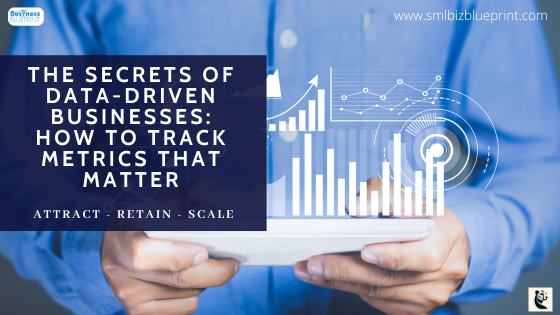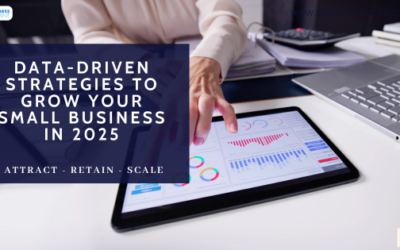Are you running your business on gut instinct rather than data?
You’re not alone—many small business owners struggle with tracking meaningful data because it seems too complex, time-consuming, or expensive.
But without the right data, you’re making decisions in the dark, wasting marketing dollars, and missing out on growth opportunities.
Here’s the reality: Businesses that use data-driven decision-making are 19 times more likely to be profitable (McKinsey & Company).
Yet, studies show that only 29% of small businesses are actually leveraging data to make strategic choices (Forrester Research).
That means the vast majority are missing out on a critical advantage.
But here’s the good news: You don’t need expensive software or a data science degree to track the numbers that matter.
With the right approach, you can start collecting and analysing valuable business data in just a few simple steps.
What You’ll Learn in This Post:
- The essential business metrics every small business should track.
- The best free and affordable tools for data tracking.
- How to automate data collection and reporting for smarter decision-making.
- How to avoid vanity metrics and focus on actionable insights that drive revenue.
By the end of this post, you’ll have a clear strategy to start tracking, understanding, and leveraging your business data—all without adding extra stress to your already busy schedule.
Let’s dive in!

#1 Why Small Businesses Need to Track Data (and What Happens If You Don’t)
Running a business without tracking key data is like driving with your eyes closed—you might make it down the road, but it’s only a matter of time before you crash.
Yet, many small businesses still operate without a clear system for collecting and analysing data.
They rely on gut feelings, rough estimates, or outdated spreadsheets, missing out on insights that could improve marketing, sales, and customer retention.
If you’re not tracking the right business data, here’s what happens:
- You waste money on ineffective marketing campaigns because you’re unsure which channels bring in the most customers.
- You lose potential sales opportunities by not understanding customer behaviour or tracking your sales pipeline.
- You struggle with cash flow management because revenue trends, expenses, and profitability aren’t being monitored in real time.
The Consequences of Not Tracking Business Data
Missed Growth Opportunities
Imagine spending thousands of dollars on ads without knowing if they’re actually bringing in sales. Without tracking conversion rates and lead sources, you could be investing in the wrong marketing strategies while ignoring high-performing channels.
Inconsistent Customer Retention
Many small businesses focus on acquiring new customers but don’t track customer retention rates or satisfaction scores. This means they fail to recognise when loyal customers are dropping off—leading to higher churn and lost revenue.
Operational Inefficiencies
Without data on inventory, project timelines, or team productivity, businesses operate inefficiently. This results in delays, wasted resources, and poor customer experiences that hurt long-term profitability.
How Tracking Data Can Transform Your Business
When businesses start tracking and analysing their data, they:
✔️ Make informed decisions—instead of guessing, they use hard numbers to allocate resources wisely.
✔️ Optimize marketing spend—by tracking customer acquisition costs and ROI, they double down on what works.
✔️ Improve customer retention—by monitoring satisfaction levels and engagement, they create better customer experiences.
Tips
- Identify One Key Metric That Drives Your Business
Instead of tracking everything, focus on one critical metric that aligns with your business goals.
For example:
If you run an e-commerce store, track your conversion rate (percentage of visitors who buy).
If you provide services, monitor your customer acquisition cost (CAC).
If you manage a local business, track repeat customer rate to improve retention. - Use a Simple, Free Tool to Get Started
You don’t need expensive software—start small with:
Google Analytics for tracking website traffic and customer behavior.
Google Sheets or Notion for organising sales and customer insights.
HubSpot CRM (free version) for tracking leads and customer interactions. - Set a Weekly Data Review Routine
Block 15-30 minutes every week to review your most important metrics. Ask yourself:
What’s working, and what’s not?
Where are customers dropping off?
How can I improve my marketing or sales based on this data?
By taking just one small step today toward tracking your business data, you’ll gain better control, make smarter decisions, and drive sustainable growth.
#2 What Types of Data Should You Track for Business Success?
Not all data is created equal.
Many businesses get caught up tracking vanity metrics—like social media likes or website traffic—without understanding which numbers drive revenue, efficiency, and customer satisfaction.
To grow a business effectively, you need to track the right Key Performance Indicators (KPIs) that directly impact profitability and long-term success.
The Four Essential Categories of Business Data
To make data work for your business, focus on these four main categories of data tracking:
Marketing Data: Understanding What Attracts Customers
Why It Matters: Marketing data helps you determine which channels bring in the most qualified leads and customers, allowing you to invest in what works and eliminate wasted spending.
✔️ Key Metrics to Track:
Website Traffic: Where do your visitors come from (Google, social media, referrals)?
Conversion Rate: What percentage of visitors take action (buy a product, book a call)?
Customer Acquisition Cost (CAC): How much does it cost to get a new customer?
Sales Data: Measuring Profitability and Business Growth
Why It Matters: Sales data helps you track revenue, profit margins, and sales trends, ensuring your business remains financially healthy.
✔️ Key Metrics to Track:
Monthly Revenue: How much are you making each month?
Average Order Value (AOV): How much does a typical customer spend?
Customer Lifetime Value (CLV): How much is a customer worth over time?
Customer Data: Improving Retention & Satisfaction
Why It Matters: Retaining customers is cheaper than acquiring new ones. By tracking customer behaviour and feedback, you can improve retention, boost loyalty, and increase long-term revenue.
✔️ Key Metrics to Track:
Customer Retention Rate: How many customers come back after their first purchase?
Net Promoter Score (NPS): How likely are customers to recommend your business?
Churn Rate: How many customers stop buying from you over time?
Operational Data: Streamlining Efficiency
Why It Matters: Tracking operational data ensures that processes run smoothly, employees are productive, and resources are used efficiently.
✔️ Key Metrics to Track:
Order Fulfillment Time: How quickly are products/services delivered?
Employee Productivity: How efficiently is work being completed?
Customer Support Response Time: How fast are customer issues being resolved?
Tips
- 🔹 1. Start With Just ONE Metric Per Category
Avoid data overwhelm. Pick one KPI from each category that aligns with your business goals. - 🔹 2. Use a Simple Dashboard to Organize Data
Track numbers weekly in Google Sheets, Notion, or a free CRM tool like HubSpot.
Colour-code metrics (green = good, yellow = needs attention, red = critical issue). - 🔹 3. Make Data-Tracking a Weekly Habit
Set aside 30 minutes each week to review progress.
Ask: What’s improving? What needs fixing? What should I change?
Tracking the right data isn’t about collecting more numbers—it’s about using meaningful insights to improve marketing, boost sales, retain customers, and run operations more efficiently.
Ready to level up your business?
Sign up for our newsletter and get expert tips delivered weekly.
#3 Best Free and Affordable Tools for Tracking Business Data
Now that you know which business data to track, the next step is choosing the right tools to collect, organise, and analyse your data.
Many small business owners assume they need expensive analytics software, but you can start tracking key metrics today with free and low-cost tools.
In this section, we’ll cover the best beginner-friendly data tracking tools, how they work, and how to integrate them into your business without any technical expertise.
Google Analytics (Free) – Track Website Traffic & User Behaviour
✔️ Best for: Tracking how visitors find and interact with your website.
✔️ Key Metrics It Helps Track:
Website traffic sources (organic, social, referral)
Bounce rate (how many visitors leave immediately)
Conversion rate (how many visitors take action)
🔹 Why You Need It:
Understanding where your customers come from and how they engage with your site helps optimise your marketing strategy and improve conversion rates.
🔹 How to Get Started:
Set up a free Google Analytics account and connect it to your website.
Track key reports weekly to understand customer behaviour.
HubSpot CRM (Free Plan) – Track Leads & Sales Performance
✔️ Best for: Organizing customer data and tracking sales progress.
✔️ Key Metrics It Helps Track:
Lead sources and conversion rates
Customer acquisition cost (CAC)
Sales pipeline progress
🔹 Why You Need It:
A CRM (Customer Relationship Management) tool helps track and nurture potential customers, ensuring no leads fall through the cracks.
🔹 How to Get Started:
Sign up for HubSpot’s free CRM and add your leads manually or through website forms.
Use the deal pipeline feature to track leads through different sales stages.
Google Sheets or Notion (Free) – Simple Data Tracking & Reporting
✔️ Best for: Businesses that need a basic, customisable tracking system.
✔️ Key Metrics It Helps Track:
Sales numbers
Marketing performance (ad spend vs. revenue)
Customer retention rates
🔹 Why You Need It:
For small businesses not ready for complex dashboards, Google Sheets or Notion offers a simple and flexible way to track data manually.
🔹 How to Get Started:
Use a free Google Sheets template to track KPIs manually.
Update your data weekly to monitor trends.
Hotjar (Free Plan) – Understand Customer Behavior on Your Website
✔️ Best for: Businesses that want to see how visitors interact with their website.
✔️ Key Metrics It Helps Track:
Heatmaps (where users click the most)
Session recordings (see real-time user activity)
Form abandonment rates
🔹 Why You Need It:
If visitors are leaving your website without taking action, Hotjar helps identify usability issues so you can make improvements.
🔹 How to Get Started:
Sign up for a free Hotjar account and install the tracking code on your website.
Analyse heatmaps and recordings to spot potential issues.
Zapier (Free Plan) – Automate Data Collection & Reporting
✔️ Best for: Automating repetitive tasks and connecting different business tools.
✔️ Key Metrics It Helps Track:
Automatically logs new customer inquiries into CRM
Syncs Google Analytics reports to Google Sheets
Sends sales notifications to Slack or email
🔹 Why You Need It:
Zapier saves time by automating data tracking tasks, ensuring all critical business data is automatically recorded and accessible.
🔹 How to Get Started:
Sign up for Zapier’s free plan and connect two apps (e.g., Google Forms + Google Sheets).
Set up a simple automation (“Zap”) to log data automatically.
Tips
- ✅ 1. Start with Just One Tool
If you don’t have any tracking in place, start with Google Analytics for website insights or HubSpot CRM for customer tracking. - ✅ 2. Automate Where Possible
Use Zapier to automate data collection and reporting to avoid manual tracking errors. - ✅ 3. Keep Your Data in One Place
Whether you use Google Sheets, Notion, or a CRM, create a single “data hub” to keep everything organised.
Using free or affordable tools, even small businesses can track key data effortlessly, make smarter decisions, and boost revenue without increasing expenses.
#4 How to Automate Data Collection for Smarter Decision-Making
Tracking business data manually is time-consuming, prone to human error, and difficult to scale.
The good news?
You can automate data collection to save time, reduce mistakes, and ensure that critical business insights are always available when you need them.
With automation tools, you don’t have to manually log sales numbers, customer inquiries, or marketing performance. Instead, real-time data flows into a dashboard where you can monitor trends, make quick adjustments, and improve decision-making—without lifting a finger.
Why Automation is Essential for Business Data Tracking
1️⃣ Saves Time & Effort
Instead of manually pulling reports, automation tools gather data and present it in real-time.
This allows business owners to focus on strategy and growth rather than repetitive data entry.
2️⃣ Reduces Human Error
Manually tracking data in spreadsheets often leads to miscalculations and inconsistencies.
Automating the process ensures accuracy and consistency across all metrics.
3️⃣ Provides Real-Time Insights
Automated dashboards allow you to instantly monitor sales, website performance, and customer behaviour.
This enables faster decision-making based on real, up-to-date data.
Best Tools for Automating Data Collection
Google Data Studio – Build Live Business Dashboards (Free)
✔️ Best for: Automating reports & tracking key performance indicators (KPIs).
✔️ What It Automates:
Sales performance (revenue, conversion rates, AOV).
Website analytics (traffic sources, bounce rates).
Marketing ROI (ad spend vs. revenue).
🔹 How It Works:
Google Data Studio connects to sources like Google Analytics, Google Ads, and CRM software, automatically pulling data into interactive reports and dashboards.
Example:
A marketing agency used Google Data Studio to track client ad performance. This automation reduced manual reporting time by 6 hours per week and improved client retention by 25% due to better transparency on campaign results.
Zapier – Automate Data Between Apps (Free & Paid Plans)
✔️ Best for: Connecting different business tools without coding.
✔️ What It Automates:
Syncs sales data from Shopify or WooCommerce into Google Sheets.
Sends new customer leads from a website form to HubSpot CRM.
Logs email subscribers automatically into an email marketing platform.
🔹 How It Works:
Zapier works by creating “Zaps”—automations that connect apps and trigger actions when certain conditions are met.
HubSpot CRM – Automate Lead Tracking & Sales Pipelines (Free Plan Available)
✔️ Best for: Automating customer relationship management (CRM).
✔️ What It Automates:
Tracks lead sources & customer interactions automatically.
Sends follow-up emails to potential customers based on engagement.
Creates real-time sales forecasts & reports.
🔹 How It Works:
When a new customer fills out a form, makes a purchase, or contacts support, HubSpot automatically tracks and categorises their activity, allowing businesses to nurture and convert leads effortlessly.
Tips
- ✅ 1. Automate a Simple, Repetitive Task First
Choose one repetitive task (e.g., logging sales in a spreadsheet) and automate it with Zapier or Google Data Studio.
Example: Set up a Zap to automatically record new customers from an order form into Google Sheets. - ✅ 2. Set Up a Live Dashboard for Business Performance
Use Google Data Studio to create an automated dashboard that updates in real-time.
Example: Track sales trends, marketing performance, and customer retention metrics in one
place. - ✅ 3. Schedule Automated Reports for Easy Monitoring
Use HubSpot CRM, Google Analytics, or Google Ads to send weekly reports via email.
Example: Receive a summary of website traffic, conversions, and ad spend every Monday morning.
With automation, you’ll spend less time collecting data and more time analysing trends, improving operations, and growing your business.

#5 Turning Raw Data Into Actionable Insights (Avoid Vanity Metrics)
Tracking data is only useful if you know how to interpret it. Many businesses collect tons of numbers but fail to turn them into meaningful insights.
Even worse, some track vanity metrics—numbers that look good on paper but don’t contribute to business growth, revenue, or efficiency.
In this section, we’ll show you how to separate vanity metrics from actionable data and how to use insights to drive real business improvements.
What Are Vanity Metrics? (And Why You Should Avoid Them)
Vanity metrics are numbers that make you feel good but don’t translate into business results.
While they may indicate some level of engagement, they often don’t provide direct insight into revenue, customer retention, or business performance.
Common Vanity Metrics & Their Alternatives:
🚫 Website Traffic → ✅ Conversion Rate (How many visitors actually buy?)
🚫 Social Media Followers → ✅ Lead Generation (Are followers turning into customers?)
🚫 Email Subscribers → ✅ Open & Click Rates (Are subscribers engaging with your emails?)
🚫 App Downloads → ✅ Retention Rate (How many users continue using the app after a month?)
How to Turn Data Into Actionable Insights
To make data useful, you need to analyse it in a way that guides decisions and actions.
Here’s how:
Identify Trends Instead of Isolated Numbers
Tracking a metric once isn’t enough—you need to analyse patterns over time to see what’s improving and declining.
✔️ Example: Instead of checking website traffic weekly, compare it month over month to see if specific campaigns are working.
Segment Data for Deeper Insights
Looking at overall data can be misleading—break it down into segments to understand your best-performing customers, products, or marketing channels.
✔️ Example: A fitness studio analysed customer data and found that repeat bookings were highest among users who attended two classes in the first week. They then offered a discount for a second class to new customers, increasing retention by 35%.
Focus on Revenue-Generating Metrics
If a metric doesn’t impact sales, profitability, or efficiency, it’s not worth tracking. The best data to analyse is the data that helps you grow your business.
✔️ Example: A service-based business stopped tracking total website visits and instead focused on qualified leads and booked calls, leading to a 20% improvement in their marketing ROI.
Tips
- ✅ 1. Set a Clear Business Goal Before Looking at Data
Example: Instead of “I want more website traffic,” ask, “How can I improve my website conversion rate?”
This shifts your focus from a vanity metric (traffic) to an actionable metric (sales conversion). - ✅ 2. Create a Monthly Data Review Routine
Set a 30-minute meeting every month to analyse trends, not just numbers.
Look for patterns in revenue, customer behaviour, and campaign success. - ✅ 3. Use a Dashboard to Track Meaningful Metrics
Use Google Data Studio, HubSpot CRM, or Google Sheets to create a live dashboard focusing only on revenue-driving data.
You can make smarter decisions, increase revenue, and improve efficiency by shifting your focus from numbers that look good to numbers that grow your business.
#6 How to Use Data to Improve Marketing, Sales, and Customer Retention
Tracking business data isn’t just about collecting numbers—it’s about using those insights to make smarter marketing decisions, improve sales performance, and increase customer loyalty.
The key is knowing how to leverage your data to optimise campaigns, refine your sales approach, and keep customers returning.
In this section, we’ll explain how to use data effectively in marketing, sales, and customer retention to maximise business growth.
Using Data to Improve Marketing Performance
Many businesses waste money on marketing campaigns that don’t generate leads or sales because they don’t analyse what’s working and what’s not.
Using data, you can allocate your budget efficiently and target the right audience.
✔️ Key Metrics to Track:
Cost Per Lead (CPL): How much are you spending to acquire a potential customer?
Conversion Rate by Channel: Which marketing platform (Google Ads, social media, email) generates the highest conversions?
Customer Acquisition Cost (CAC): How much does it cost to gain a new paying customer?
🔹 How to Use This Insight:
Double down on marketing channels that generate high conversions.
Pause or optimise campaigns with low conversion rates.
Using Data to Boost Sales Performance
Sales teams often waste time on unqualified leads or low-priority customers because they lack data-driven insights.
Tracking sales metrics helps businesses close more deals, shorten the sales cycle, and improve profitability.
✔️ Key Metrics to Track:
Lead-to-Customer Conversion Rate: How many leads actually turn into paying customers?
Average Deal Size: What’s the typical revenue per sale?
Sales Cycle Length: How long does converting a lead into a customer take?
🔹 How to Use This Insight:
Prioritise high-value leads based on their likelihood to convert.
Automate follow-ups to reduce response time and improve conversions.
Using Data to Increase Customer Retention
Acquiring new customers is essential, but retaining existing customers is more profitable—it’s 5X cheaper to keep a customer than to acquire a new one.
Businesses that track customer retention data can improve loyalty, reduce churn, and increase repeat purchases.
✔️ Key Metrics to Track:
Customer Retention Rate: What percentage of customers return after their first purchase?
Net Promoter Score (NPS): How likely are customers to recommend your business?
Customer Churn Rate: How many customers stop buying from you over time?
🔹 How to Use This Insight:
Identify customers at risk of leaving and offer incentives to stay.
Use personalised email campaigns to improve customer engagement.
Tips
- ✅ 1. Run A/B Tests to Improve Marketing & Sales
Example: Test two landing page headlines and track which one converts better. - ✅ 2. Create a “Best Customer” Profile Based on Data
Identify your most profitable customers and target similar people in marketing campaigns. - ✅ 3. Automate Personalized Follow-Ups
Email automation (Mailchimp, Klaviyo, or HubSpot CRM) can send targeted messages based on customer behaviour.
You can improve decision-making, reduce wasted spending, and increase overall profitability by leveraging business data for marketing, sales, and customer retention.
Transform your business with insights that matter.
Subscribe to Pulse for exclusive strategies designed to drive your success.
Join Pulse Now
Conclusion
Tracking business data doesn’t have to be complicated or expensive.
By focusing on the right metrics, using free and affordable tools, automating data collection, and turning raw numbers into actionable insights, you can make smarter decisions, improve marketing efficiency, boost sales, and increase customer retention.
Key Takeaways from This Post:
- ✔️ Tracking the right data is essential—focus on metrics that impact revenue, efficiency, and customer retention, not vanity numbers.
- ✔️ Use free and affordable tools like Google Analytics, HubSpot CRM, Google Sheets, and Hotjar to start collecting meaningful data.
- ✔️ Automate data tracking with Zapier, Google Data Studio, and CRM tools to save time and reduce human error.
- ✔️ Analyze trends, not just numbers—look for patterns in customer behaviour, sales performance, and marketing ROI to make better decisions.
- ✔️ Use insights to optimise marketing, sales, and retention strategies—double down on what works and eliminate what doesn’t.
Ready to Take Action?
Here’s Your Next Step:
🔹 Start Small: Pick one key metric from each category (marketing, sales, customer retention, operations) and start tracking it today.
🔹 Use a Free Tool: Set up Google Analytics for website traffic or HubSpot CRM for customer tracking—both are free and easy to implement.
🔹 Automate Where Possible: Try Zapier or Google Data Studio to make data collection effortless.
By implementing even one or two of these strategies, you’ll gain better control over your business, make data-driven decisions, and accelerate growth without guesswork.
🔹 What’s one business metric you’ll start tracking today?
Drop a comment below, and let’s discuss!
FAQs
Q1: Why is tracking business data important?
A2: Tracking business data allows you to make informed decisions instead of relying on guesswork. It helps you understand customer behaviour, marketing effectiveness, sales performance, and operational efficiency, ultimately leading to higher revenue and business growth.
Q2: What are the most critical business metrics to track?
A2: The most valuable metrics depend on your business goals, but some key ones include:
Marketing Data: Conversion rate, cost per lead (CPL), customer acquisition cost (CAC).
Sales Data: Revenue, average order value (AOV), lead-to-customer conversion rate.
Customer Data: Retention rate, Net Promoter Score (NPS), churn rate.
Operational Data: Order fulfilment time, employee productivity, support response time.
Q3: What are vanity metrics, and why should I avoid them?
A3: Vanity metrics are numbers that look good on paper but don’t impact your bottom line. Examples include social media followers, website traffic, and app downloads if they don’t lead to actual conversions or revenue. Instead, focus on actionable metrics like lead conversions, customer retention, and sales growth.
Q4: What are the best free tools for tracking business data?
A4: Some of the best free tools to get started include:
Google Analytics – Tracks website traffic and user behaviour.
HubSpot CRM – Manages customer interactions and sales tracking.
Google Sheets – A simple way to track key metrics manually.
Hotjar – Provides heatmaps and visitor behaviour insights.
Zapier – Automates data syncing between different apps.
Q5: How can I automate business data tracking?
A5: To save time and reduce human error, use:
Google Data Studio to create live dashboards.
Zapier to connect apps and automate data collection.
HubSpot CRM to track leads and automate sales follow-ups.
Email marketing tools (Klaviyo, Mailchimp) to automate customer engagement tracking.
Q6: How often should I review my business data?
A6: Marketing & sales metrics: Weekly to track performance trends.
Customer & operational data: Monthly to monitor retention, support efficiency, and employee productivity.
Financial & revenue data: Quarterly to analyse profitability and adjust business strategies.
Q7: What is the easiest way to get started with data tracking?
A7: Start by tracking one key metric in each category (marketing, sales, customer retention, and operations). Use free tools like Google Analytics and Google Sheets to log and analyse data, then gradually add automation tools as needed.
Other Articles
Business Growth vs. Scaling: Key Differences & Best Strategies
Best AI Tools for Content Creation: 7 Must-Try Solutions to Boost Your Workflow Today




